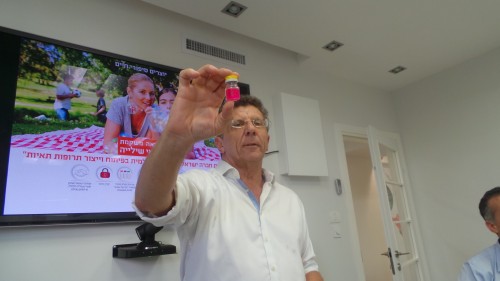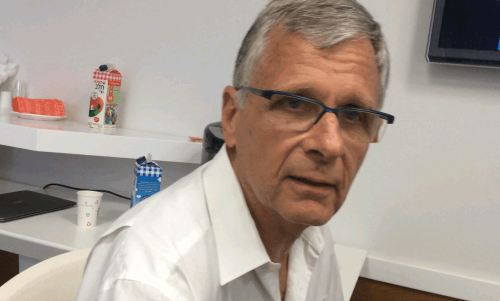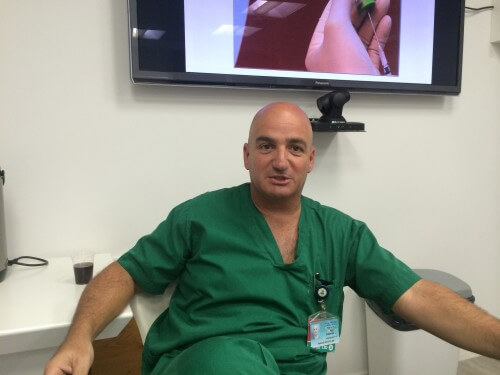"In the next ten years, the NIH will fund many studies of the placenta, an organ that until now was considered medical waste, and today we understand its potential as a source of stem cells for healing." This is what Pluristem CEO Zami Aberman said during a press tour held at the company's factory, which develops healing applications from placental cells from donors undergoing cesarean sections Prof. Ron Gonen of Bnei Zion: In the future it will be possible to inject placental cells into women suffering from preeclampsia; Dr. Erez Kahl, Sheba: dispersion of placental cells in the blood system will allow the removal of the substances that clog them in all the arteries in the body at the same time

"The placenta research project was announced by the NIH (the National Institutes of Health, the American equivalent of the Ministry of Health), which constitutes global recognition of the uniqueness of the placenta," said Pluristem CEO Zami Aberman during a press tour held at the factory in the Matam industrial area at the entrance to Haifa, and which He revealed the production process that allows the company to produce cells capable of curing various types of diseases, and in order to 'program' them for the type of healing you simply need to control the environmental conditions when multiplying. The origin of the cells is in the placentas donated from women giving birth by caesarean section at the Bnei Zion and Rambam hospitals in Haifa with the consent of the obstetricians. It is worth emphasizing that the company, despite its 15 years of existence, still does not have a single product on the market, and that all the test tubes it produces, which are filled with cells dedicated to curing diseases that will be detailed later, are intended for clinical trials in five countries.
The meeting was also attended by Prof. Ron Gonen, Director of the Department of Maternity and Delivery Rooms and the High-Risk Pregnancy Unit and Senior Deputy Director of the Women's and Maternity Department, at the Bnei Zion Medical Center who spoke about the new role of the placenta in modern medicine and the potential of stem cell treatment from the placenta for preeclampsia and Dr. Erez Kahal - Cardiac surgery specialist, director of the post-cardiac surgery wound clinic at Sheba Tel Hashomer Hospital who spoke about the role of stem cells from the placenta in curing arteriosclerosis (in the coronary arteries and in the blocked leg arteries in diabetics).
But first, Aberman explained the process developed by the company, which is traded at the same time on Nasdaq and BTA, and about the transformation it went through. This is a technology developed in the nineties partly at the Weizmann Institute and partly at the Technion for the production of bioreactors - in fact it is a kind of test tubes with a substrate containing stem cells. In the first two thousand years, the feasibility of using them to reproduce stem cells from umbilical cord blood was proven.
"The company's model at the beginning was that of a medical equipment company, which wanted to sell the bioreactors and receive royalties on them. When I joined the company in 2005, we changed the business model and became a therapeutic company, with the bioreactor being the device that gives us a relative advantage over the competing company , without which (the genes linked to the three-dimensional growth of the cells are protected by patents and within minutes you can tell if the patent has been violated) she is forced to use a lot of manpower. We have developed mechanization that allows us to produce in Haifa despite the high costs that characterize a western country.
According to Aberman, the field of cellular therapy is divided into two types: the first type is cells taken from the patient himself and injected into him, mainly artificial skin and artificial cartilage, and the future vision is the production of 'spare parts' for the body (as in the example published just a week ago when the sensation of a paralyzed man in Poland returned to him after an injection operation cells from the nose to the spine). Over 3,000 companies operate in this field.
The second type - cells for general transplantation is a relatively new field and four main companies operate in it, of which Pluristem is one, as well as the Australian Mesoblast (partially owned by Teva), the American Atharsis and Capricor.

- "The mechanism of action we offer is not a replacement, but a sophisticated drug delivery system that knows how to secrete many drugs in an adaptive manner to the patient's condition."
Adult stem cells have many sources: bone marrow, umbilical cord blood, fat and also the placenta. We chose the placenta because the placenta is the only place in nature where two bodies live with each other in coexistence (except in cases of preeclampsia). We take the cells from the area connecting the mother and the baby. These are special cells located in a special area that allow the injection of cells without any adjustment: - Unique immunological properties (unmatched)
- Secretions of various medical proteins
- Changing the immune system
- Encouraging the creation of new blood vessels
- Protection of other cells from extreme conditions
- young cells
- stable cells
- About 30 hours doubling time (efficient production)
- Source available without ethical restrictions.
- 30 thousand test tubes can be produced from one placenta. 100 million cells in each test tube.
The PLX cells originate from the postnatal human placenta. 4 hours after birth, cell multiplication is carried out on a unique platform in the GMP facility we developed. The PLX cells are then frozen and stored ready for use for two years. After that, we use a dedicated thawing device at the treatment site without causing damage to the cells and to ensure the quality of the cells before injection into the human body. The PLX cells change the secreted protein profile depending on the patient's condition. And finally, the secreted proteins initiate a self-healing process and significantly improve the patient's condition.
So far, the company has carried out phase one trials (animals, mainly mice and rats) using cells and phase 2 clinical trials on approximately 150 patients in the following fields: in the blood vessels and heart field - severe arteriosclerosis in the lower limbs, and intermittent lameness (in diabetic patients), in the field of orthopedics - Injuries in the muscle and tendon treatment of the shoulder rotators, in the area of the lungs - hypertension in the lungs, and in the seam between the pre-clinical stage and the first stage - treatment with cells derived from the placenta to repair damage in another placenta - preeclampsia.
In the intermittent limp experiment, we were able to reduce the risk of amputation or death in diabetic patients by 59%. The last experiment we published in January of this year showed an improvement in patients who underwent hip replacement surgery.
"The Pluristem process is perhaps the first application of epigenetics. We do not genetically change the cells, but the environment in which they grow - the pressure, the acidity, etc., and by playing with the environmental conditions we were able to transform placental cells into cells that can secrete substances into the environment. For example, if you challenge the cells inside the bioreactor with hypoxia, they will produce blood vessels, if you put inflammatory substances in the solution, the cells are challenged to produce anti-inflammatory substances."
In response to the question of one of the reporters, will this treatment replace the treatment of the stem cells, whose preservation became a big industry in the previous decade: "In the world today, about one and a half billion cord blood doses are stored, but only about 3,000 transplants were performed per year. Doctors hesitate to inject umbilical cord blood into the child himself or one of his relatives, for all kinds of medical reasons. I recommended to my children to donate the umbilical cord blood of the grandchildren upon their birth to a public bank.
At the end, Aberman gave the journalists a tip: all products based on stem cells for general use are in clinical trials, "If someone sells you a cellular cure that is already working, he is a charlatan."
The wonderful world of the placenta

Prof. Ron Gonen, Director of the Department of Maternity and Delivery Rooms at the Bnei Zion Medical Center described the function and structure of the placenta: "The placenta is a unique organ with a very short lifespan of nine months that is characterized by rapid growth, differentiation and maturation
The placenta performs different functions at the same time: the passage of gases and nutrients between the mother and the fetus and back (carbon dioxide); protection against rejection; production of various hormones; and ensuring the normal development of the pregnancy.
An average placenta in the ninth month has a diameter of 15-20 cm and weighs about 500 grams. The placenta has the maternal side which is a kind of big ball, and there is the side which is attached to the fetus. Between the maternal side and the fetal side there is a space filled with maternal blood that arrives in the uterine arteries. On the fetal side there is a branched structure of vasculature in which fetal blood flows. The roots of the placenta on the side of the fetus are the place where the exchange of gases and food is done without mixing between the blood of the mother and the blood of the fetus, thanks to the thin membranes.
The placenta begins to develop after the implantation of the fetus. The fertilized egg begins to divide while moving towards the uterus and about a week later it reaches the uterus and implants there. After rooting, the embryo differentiates into cells, some of which will continue to develop as an embryo and some of which will develop into the placenta.
"Tolerance" of the mother towards the fetal tissue
"Why doesn't the process of rejecting a foreign implant against the fetus occur in the body?" Prof. Gonen asks. And replies that in this issue the hidden is greater than the visible. In the "contact" areas, various systems operate that aim to prevent the process of rejection of the fetus as happens after the implantation of a foreign organ, on the one hand these systems enable the "tolerance" of the mother towards the fetus and on the other hand they monitor the entire process of creating blood vessels in the placenta and limit the depth of their penetration to the uterine arteries.
Improper implantation of the placenta is the cause of preeclampsia and retardation of the growth of the fetus. The cilia of the placenta penetrate into the maternal blood and expand them. When this happens the pregnancy develops normally. When this does not happen properly, when the embryonic cells fail to penetrate and expand the blood vessels, they are narrower and there is greater resistance.
Preeclampsia is a disease that endangers mother and fetus, and it occurs in 3-5% of pregnancies. Among the symptoms it causes to the mother: hypertension and excretion of protein in the urine, risk of multisystem damage to the eyes, liver, kidneys, blood clotting system and brain. Preeclampsia is one of the causes of maternal mortality and a leading cause of morbidity and mortality of the newborn. She still has no treatment except for terminating the pregnancy.
Next, Prof. Gonen describes the results of an experiment in pregnant mice conducted with Pluristem's cells:
"Treatment with the Pluristem preparation produced from the placenta - PLX-PAD resulted in the normalization of: blood pressure, urinary protein excretion, blood vessel function, placental function, inflammatory and immunological processes, and all this without causing harm to the fetuses.
Although the exact mechanism of action of PLX-PAD in the treatment of preeclampsia is still unclear, the results indicate that PLX-PAD may have the potential to be an innovative and unique treatment for preeclampsia
Will this research lead to closing the circle? Will the placenta that can cause preeclampsia be used as "raw material" to create the medicine that will cure the disease?
The idea of taking cells from a healthy placenta to repair a damaged placenta.
Will Pluristem's research lead to closing the circle? Will the placenta that can cause preeclampsia be used as "raw material" for the production of the medicine that will cure the disease.
Gonen's department assists in the recruitment of placenta donors - mothers destined for a planned caesarean section at the Bnei Zion Medical Center. They receive an explanation in writing and in writing about the purpose of the study from a senior doctor, undergo questioning about diseases and infections and sign a consent form for placenta donation for the purpose of research - approval of the Helsinki Committee of the Ministry of Health and the Medical Center. In addition, as part of the blood collection for the routine tests, similar tests are conducted for the mother "A uses them to detect infectious diseases.
Gonen emphasizes that the placenta has no other use and is usually thrown away as biological waste and that a caesarean section is simply the only way to receive the placenta in a sterile form. According to him, the response percentage of the women is almost 100%, including religious women, who call the rabbi. The few who do not donate are religious women whose rabbi was not available on the phone.
After the baby is removed, the placenta is packed in a sterile bag while maintaining anonymity (instead of the patient's details there is a number that only the doctor knows) and is immediately transferred to the multisystem in a cooling tank.
remove the fats from the blood vessels without surgery

The next lecturer was Dr. Erez Kahl, a heart surgeon at Tel Hashor, who serves as the safety officer for the clinical trials in Pluristem, a position in which the employee liked to be an outsider to the system. "I have more than ten years of experience in the whole subject of CELL THERAPY. I was a partner in the development of a product and in consulting for several companies. Among other things, Dr. Kahl described the possibilities of cellular therapy in atherosclerosis.
"Stem cells are self-renewing cells capable of differentiating into different cell lines. Their main advantage is their ability to reach different body organs and different tissues affected by disease or injury, to secrete there cytokines, proteins and other growth factors necessary for the healing of that organ or tissue. They are relatively simple in their production, growth and reproduction and in their immunomodulatory capacity - masking the activation of lymphocytes and APC, effect on NK cells and other cells
Stem cells differ from the rest of the body's cells in two ways: ability to regenerate: stem cells can divide an infinite number of times, to provide new cells for a given tissue throughout a person's life; Plasticity: when a stem cell divides, each new cell has the potential to remain a stem cell or to differentiate into another cell type with a more defined function, for example: muscle cell, blood cell or liver cell
The large number of companies in the world and the amount of medical research (more than 500 studies) in the field of cellular therapy indicate the importance of this treatment and the hopes of the scientific world that a new line will come from here.
Arteriosclerosis - Atherosclerosis is a multisystem disease in which the arteries are gradually blocked due to the accumulation of fatty material under the inner wall of the artery, and an inflammatory reaction develops in which a sclerotic plaque (plaque) settles in the walls of the artery consisting of cholesterol that has settled from LDL, fatty components, white blood cells that accumulate due to the process Inflammation, platelets and more. Arteriosclerosis can develop in different arteries in the body and damage the organs fed by them: brain, heart, kidneys, eyes, limbs and more. Parts of the plaque can detach from the artery wall and block another area.
The risk factors for atherosclerosis are: genetics, diabetes, hypertension, diet, physical inactivity. The main vulnerabilities in the disease: coronary arteries in the heart - ischemia, heart attacks, heart failure and death; Carotid and brain arteries - TIA, CVA; Leg arteries - pain at rest, pain on exertion (IC), wounds (CLI), necrosis, amputations, sepsis and mortality; Eyes, kidneys, aorta and more.
The currently common treatments against arteriosclerosis include drug therapy, cintotherapy (balloons, stents) and, if there is no choice, then surgical intervention. In many cases, these treatments are insufficient, do not solve the problem, treat locally and not systemically, have side effects, some of them invasive, include complications and risks, and most importantly - they do not treat the mechanism but the symptom. Only treatment at the cellular level, and intervention or imitation of the healthy mechanism will solve the problem
There are many clinical studies today on the subject and it has the potential to cure diseases - cardiovascular diseases, autoimmune diseases, cancer, sports injuries and orthopedic diseases, diseases of the circulatory system, diseases of the nervous system, trauma.
The difference between Pluristem's cells and other cells that are used in a therapeutic basket is the ability to manipulate them in the direction you want. Others do not know how to direct the cells to treat the stage where the disease is stuck.
The mechanism of action of the cells that Plurisystem produces is based on the body's ability to heal itself by releasing the cells (cytokines, proteins, growth factors, etc.) according to the signals given to them in the growing conditions and the factors that are added to them during the growing (Challenging and Culture conditions).
"When I started specializing in heart surgery 12 years ago and we did huge and big surgeries and little by little medicine is moving to minimal invasiveness, and even catheterization. Medicine is going for minimal intervention. We used to do surgery to replace the aorta - very complicated and today stents are used in most cases. The next step will have to be the cellular therapy, which is a completely different concept
According to him, Pluristem's method is expected to inject cells into the body that will disperse in the blood vessels and dissolve the plaque layer that clogs them, and thus we will be able to benefit from a complete systemic treatment of all the blood cells and not only where it is visible (the heart or the legs).
According to him, a combination of all the benefits of cellular therapy with the use of the most potent stem cells in the body - the placental cells while utilizing the principle of Challenging and Cultures Condition to treat a variety of complex diseases such as arteriosclerosis, cardiovascular, orthopedic and pulmonary and even the slowing down of aging. The whole western world is looking for the solution. It surely lies in cellular healing, but it is not known who will get there first. Another advantage is that it is an off-the-shelf product that is ready for the doctor to use, and does not require complicated and complex injections.

3 תגובות
Hello, I have rheumatoid arthritis
Since 1993, he has been treated with Shiba. The current treatment is with Mevtra, which has improved the indicators of the disease
The disease affected the right hip joint with an erosion in the femur that caused a limb to be shortened by 4 cm, which led to lameness accordingly.
I am interested in helping with your research p
Restore the damaged limb (femur) and avoid joint replacement surgery.
I would love to be in touch with you
Thank you Avraham Chaim Pender 0547179414